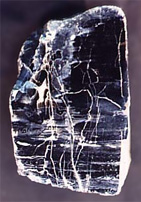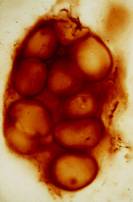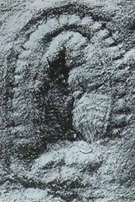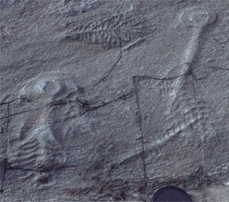Online exhibits : Geologic time scale
First, a few words about the Precambrian, an informal name for the vast expanse of time prior to the Phanerozoic Eon (which includes the Paleozoic, Mesozoic, and Cenozoic Eras). The Earth formed. It then took nearly four thousand million years before the first animals would leave their traces on the planet. This span of time makes up roughly seven-eighths of the Earth's history. During the Precambrian, the most important events in biological history took place. Consider that the Earth formed, life arose, the first tectonic plates arose and began to move, eukaryotic cells evolved, the atmosphere became enriched in oxygen — and just before the end of the Precambrian, complex multicellular organisms, including the first animals, evolved.
The Precambrian is divided into three eons. From youngest to oldest, they are: the Proterozoic, the Archean, and the Hadean (this latter being an informal name).
The Proterozoic Eon
The period of Earth's history that began 2.5 billion years ago and ended 542.0 million years ago is known as the Proterozoic, which is subdivided into three eras: the Paleoproterozoic (2.5 to 1.6 billion years ago), Mesoproterozoic (1.6 to 1 billion years ago), and Neoproterozoic (1 billion to 542.0 million years ago).* Many of the most exciting events in the history of the Earth and of life occurred during the Proterozoic — stable continents first appeared and began to accrete, a long process taking about a billion years. Also coming from this time are the first abundant fossils of living organisms, mostly bacteria and archaeans, but by about 1.8 billion years ago eukaryotic cells appear as fossils too.
With the beginning of the Mesoproterozoic comes the first evidence of oxygen build-up in the atmosphere. This global catastrophe spelled doom for many bacterial groups, but made possible the explosion of eukaryotic forms. These included multicellular algae, and toward the end of the Proterozoic, the first animals.
Life
The first traces of life appear nearly 3.5 billion years ago, in the early Archean. However, clearly identifiable fossils remain rare until the late Archean, when stromatolites, layered mounds produced by the growth of microbial mats, become common in the rock record. Stromatolite diversity increased through most of the Proterozoic. Until about one billion years ago, they flourished in shallow waters throughout the world. Their importance for understanding Proterozoic life is tremendous; stromatolites that have been silicified (forming a type of rock known as stromatolitic chert) often preserve exquisite microfossils of the microbes that made them (see two photos, below left).
 |
 |
 |
 |
 |
 |
 |

From left, (1) A sample of stromatolitic chert from the Bitter Springs Formation of central Australia, about 850 million years old. Note the typical fine banding patterns. (2) Cyanobacteria, probably Myxococcoides minor, a colonial chroococcalean form from the Bitter Springs chert. (3) Kimberella was a bilaterally symmetric Ediacaran animal that had rigid parts — note the deep depression that a rigid shell-like covering made in the silt upon burial. This specimen, from the White Sea region of Russia, is about 1.5 cm across and 2.5-3 cm long. (4) Two specimens of Charniodiscus from Mistaken Point, Newfoundland. These Ediacaran organisms have a bulb-shaped or disc-shaped "holdfast" which was attached to the sea floor, and a leaf-shaped main body that probably was held up in the water column. |
Stromatolites began to decline in abundance and diversity about 700 million years ago. A popular theory for their decline (though certainly not the only possible explanation) is that herbivorous eukaryotes, perhaps including the first animals, evolved at about this time and began feeding extensively on growing stromatolites. Stromatolites are rare fossils after about 450 million years ago. Today, they are found only in restricted habitats with low levels of grazing, such as the shallow, saline waters of Shark Bay, Australia.
The oldest fossil that may represent a macroscopic organism is about 2.1 billion years old. Several types of fossil that appear to represent simple multicellular forms of life are found by the end of the Paleoproterozoic. These fossils, known as carbon films, are just that: small, dark compressions, most resembling circles, ribbons, or leaves; they are most common and widespread in the Neoproterozoic. Some resemble seaweeds and may represent eukaryotic algae; we know from independent evidence that red algae and green algae appeared in the Proterozoic, probably over one billion years ago.
There are tantalizing hints from trace fossils and molecular biology that animals may have appeared as much as one billion years ago. However, the oldest relatively non-controversial, well-studied animal fossils appear in the last hundred million years of the Proterozoic, just before the Cambrian radiation of taxa. The time from 635 million years ago to 542 million years ago, known as the Ediacaran Period (sometimes called the Vendian), saw the origin and first diversification of soft-bodied organisms (see two photos, above right). The period and the fauna are named after the Ediacara Hills of southern Australia, where the first abundant and diverse fossils of this kind were found.
Ancient global pollution
The first "pollution crisis" hit the Earth about 2.2 billion years ago. Several pieces of evidence — the presence of iron oxides in paleosols (fossil soils), the appearance of "red beds" containing metal oxides, and others — point to a fairly rapid increase in levels of oxygen in the atmosphere at about this time. Atmospheric oxygen levels in the Archean had been less than 1% of present levels, but by about 1.8 billion years ago, oxygen levels were greater than 15% of present levels and rising. It may seem strange to call this a "pollution crisis," since most of the organisms that we are familiar with not only tolerate but require oxygen to live. However, oxygen is a powerful degrader of organic compounds. Even today, many bacteria and protists are killed by oxygen. Organisms had to evolve biochemical methods for rendering oxygen harmless; one of these methods, oxidative respiration, had the advantage of producing large amounts of energy for the cell, and is now found in most eukaryotes.
Where was the oxygen coming from? Cyanobacteria, photosynthetic organisms that produce oxygen as a byproduct, had first appeared 3.5 billion years ago, but became common and widespread in the Proterozoic. Their photosynthetic activity was primarily responsible for the rise in atmospheric oxygen.
Proterozoic fossil localities
Bitter Springs Formation: The oldest known eukaryotic fossils come from this Late Proterozoic dolomite in central Australia.
Ediacara Hills: Fossils of some of the oldest known animals were discovered at this Australian locality in 1946.
Mistaken Point, Newfoundland: Mysterious fossils from the coast of Newfoundland.
Nopah Range: The oldest sedimentary rocks in this Southern California region are 1.5 billion years old; younger deposits are rich in stromatolites.
White Sea: Located on the northern coast of Russia, this has been a site of active research by UCMP into the Vendian fauna.
Resources and references
- Hofmann, H.J. 1994. Proterozoic carbonaceous compressions ("metaphytes" and "worms"). Pp. 342-357 in S. Bengtson (ed.), Early Life on Earth. Columbia University Press, New York.
- Holland, H.D. 1994. Early Proterozoic atmospheric change. Pp. 237-244 in S. Bengtson (ed.), Early Life on Earth. Columbia University Press, New York.
- Learn more about the Ediacaran Period and Ediacaran biota on Wikipedia.
- Find out more about the Precambrian paleontology and geology of North America at the Paleontology Portal.
- See the Wikipedia page on the Proterozoic.



